A HARD FOUGHT SHIP
The
story of HMS Venomous
Warren Elmore Smith, Ordinary Telegrapher SA330406
Warren Smith joined HMS Hecla at Simon's Town on 8 October one month before she was torpedoed
Warren Elmore Smith was born in Cape Town on 11 December 1924, the son
of William Elmore Smith who worked for Johannesburg's city hall for
thirty years. Warren was a local government clerk living at home
with his parents in Judith's Paarl, Johannesburg, when he volunteered to
join the Navy on 1 June 1942. He looks a very carefree young man in the
photograph as a Sea Cadet (below right) but far more serious in the
portrait on the left taken in 1943 after Hecla was torpedoed and he was rescued by HMS Venomous.
His younger brother, Dennis Smith, who lives in Australia recalled that he
was known for his cheerfulness and sense of humour, but the experience
of that night left a dark shadow in his life.
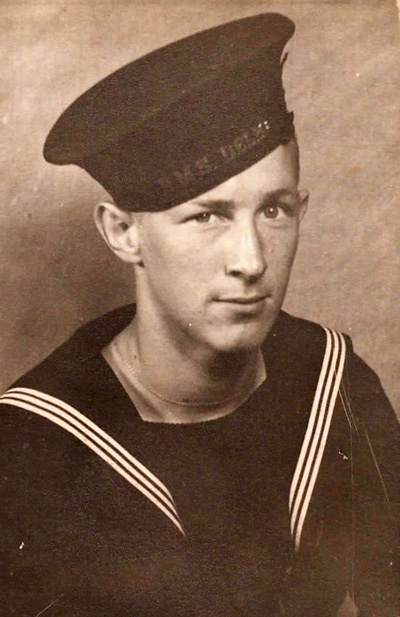
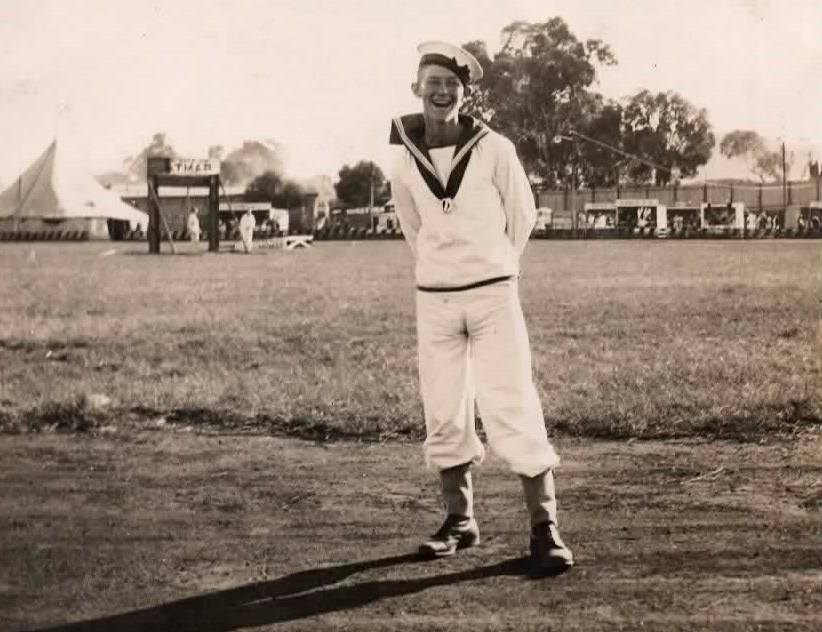 Warren Elmore Smith and his
younger brother Dennis were both Sea Cadets at Wemmer Pan, a lake on
the southern side of Johannesburg
They were in the band, Warren was a drummer and Dennis a buglar
Warren Elmore Smith and his
younger brother Dennis were both Sea Cadets at Wemmer Pan, a lake on
the southern side of Johannesburg
They were in the band, Warren was a drummer and Dennis a buglar
Hecla left Simon's Town in late October and called in at Freetown where HMS Vindictive was the destroyer depot ship. The two depot ships left together and were met by their destroyer escorts, HMS Venomous and Marne. The Navigating Officer in Hecla, Lt Cdr Henry C.R. Alexander RN, wrote a vivid account of events leading up to the disaster. Warren Smith never described what happened when Hecla sank, all we have are a few fragmentary memories relayed to me by his son, but it appears that as Hecla
heeled over to port and the water began to lap over the deck he
decided, like many others, not to step over the rail into the sea and
risk the ship topling over on top of him but climbed up the steeply
shelving deck to the starboard rail and walked down the hull to the
bilge and from there slid into the sea, badly scrapping his backside
and legs on barnacles and other marine growth.
HMS Marne was standing by to pick up the senior officer from Hecla
when she was hit in the stern and the men in the water were pummeled by
her exploding depth charges as they broke loose and sank. Warren Smith
in common with most survivors would have been in the water for many
hours, possibly hanging onto a Carley float while Venomous
broke off the rescue of survivors to follow Asdic and visual sighting
of the attacking U-Boat. His experiences would have been very similar
to that of other survivors described on this website.
The full story of the circumstances leading to the sinking of HMS Hecla and the rescue of survivors by HMS Venomous and Marne is told in A Hard Fought Ship. Warren Smith arrived in Gibraltar aboard HMS Venomous on Saturday 14 November. He took no part in the landings in North Africa but most of the Hecla survivors returned to Britain for their two weeks survivors' leave on one of the troop carriers, the converted liner Reina del Pacifico.
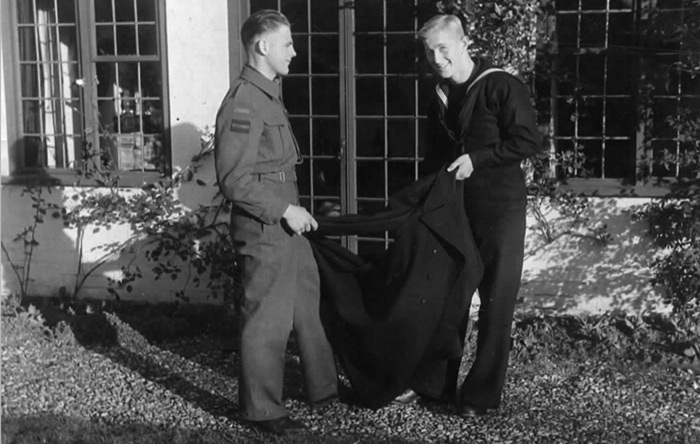 The photograph of him wearing a cap with the ribbon of the light cruiser HMS Delhi
which was badly damaged by German bombers at Algiers on the 22nd
November and limped back to Gibraltar for emergency repairs before
returning to Britain in December suggests that Warren joined her for
the voyage.
The photograph of him wearing a cap with the ribbon of the light cruiser HMS Delhi
which was badly damaged by German bombers at Algiers on the 22nd
November and limped back to Gibraltar for emergency repairs before
returning to Britain in December suggests that Warren joined her for
the voyage.
It seems appropriate in view of the hospitalty offered to servicemen by
families in South Africa that on arrival in Britain for the first time
he should have been a guest in the home of the Conservative MP Sir William "Billy" Brass
in the village of Chattisham near Ipswich where he was photographed
folding a greatcoat with a Canadian soldier whose name was given on the
reverse as McCormick. Astonishingly, Roger Smith found the house little changed and still recognisable when he visited it some years back.
Sailors were not permitted to wear cap ribbons identifying their ships
in wartime and he may have been lent the cap by a long service rating
on Delhi so that he could have this studio photograph taken to send home to his parents in Johannesburg.
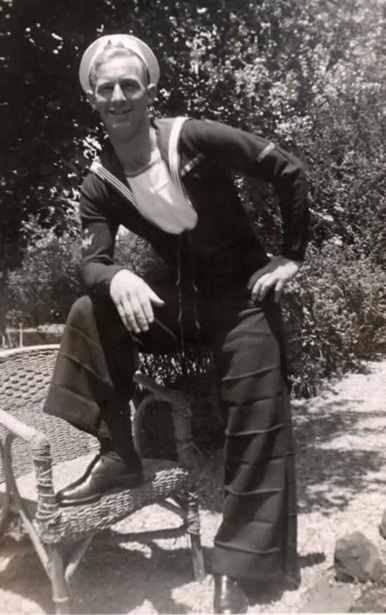 This
was Warren Smith's first visit to the country his family had left at
the end of the previous century. It was a country divided by class
rather than colour but it was also a country at war where men were away
from home in the armed forces and women were doing men's jobs. We do
not know how long he stayed in Britain after his two weeks survivor's
leave but we do know that during this time he met Len Ellis, a fellow
South African on survivors leave from the RN after his ship was
torpedoed taking amnumition to Malta. This led to Warren Smith's
younger brother Dennis meeting and marrying Len's sister Yvonne. Len
Ellis transferred to the South African Navy and ended up as Yeoman of
Signals and Aide to Admiral Bierman. Dennis wanted to join the SAN but
was told to "go back to school" so he added a year to his age and
"ended up serving in Italy with the 67th SA Armoured Division".
This
was Warren Smith's first visit to the country his family had left at
the end of the previous century. It was a country divided by class
rather than colour but it was also a country at war where men were away
from home in the armed forces and women were doing men's jobs. We do
not know how long he stayed in Britain after his two weeks survivor's
leave but we do know that during this time he met Len Ellis, a fellow
South African on survivors leave from the RN after his ship was
torpedoed taking amnumition to Malta. This led to Warren Smith's
younger brother Dennis meeting and marrying Len's sister Yvonne. Len
Ellis transferred to the South African Navy and ended up as Yeoman of
Signals and Aide to Admiral Bierman. Dennis wanted to join the SAN but
was told to "go back to school" so he added a year to his age and
"ended up serving in Italy with the 67th SA Armoured Division".
All we have to go on in tracing Warren Smith's subsequent service in
the SAN is his service record which gives dates, shore bases (for pay
and administrative purposes) and reports from senior officers but
little else and is often difficult to interpret. If taken at face value
it would appear that from 12 November 1942 when HMS Hecla sank until 25 July 1943 he was attached to HMS Assegai,
a shore base near Durban "which was a collecting point to supply
personnel for naval ships of the Eastern Fleet" based at Mombasa on the
east coast of Africa. He then transferred to HMS Gnu (formerly HMS Africander III), a shore base near Cape Town. The reports in his service record show he was
well thought of. The report by the Lieutenant in charge of his Division
at HMS Gnu is fairly representative, describing
him as "a good type but lacks experience, always cheerful and carries
out his work to the best of his ability."
There is nothing in his service record to suggest he served on another ship between Hecla sinking and joining HMS Test, a River Class Frigate, on 25 August 1944. He was a Telegraphist on Test on operations in the Indian Ocean until 8 November 1945. He
might easily have been killed in an incident off the Burmese coast on
13th July 1945 when three crew members died and others were wounded. A
boat sent in with a party to gather intelligence on Japanese forces at
the mouth of the Tavoy River came under fire from an enemy position.
The dead included a fellow South African, Able Seaman Donald Sanders.
The others killed were Lieutenant Gordon Hustler and Able Seaman
Raymond Allen.
The photograph on the right
was taken in 1946 soon after he was released from the SANF. After the
war, Warren returned to Johannesburg. He and his brother Dennis, who
had seen war service with the 6th SA Armoured Division in Italy, joined
the Johannesburg Fire Brigade. Warren married Doreen Scott and they had
three children. Sadly he was only 36 when he died in 1960; his children
grew up without knowing their father and their Uncle emmigrated to
Australia. This brief outline of Warren Smith's short life is based on
the few details his son Roger and his uncle Dennis Smith were able to
tell me. He was lucky to survive the sinking of his first ship
HMS Hecla
and to mary and leave a family behind. His widow is now 88 and living
in Johannesburg but his son Roger moved to Britain in 1989.
The story of HMS Venomous is told by Bob Moore and Captain John Rodgaard USN (Ret) in
A Hard Fought Ship
A Hard Fought Ship contains the most detailed account of the loss of HMS Hecla yet published
Buy the new hardback edition online for £35 post free in the UK
Take a look at the Contents Page and List of Illustrations
Holywell House Publishing
88 Holywell Hill, St Albans, Hertfordshire AL1 1DH, Britain
http://holywellhousepublishing.co.uk
Telephone: +44 1727 838595
contact online









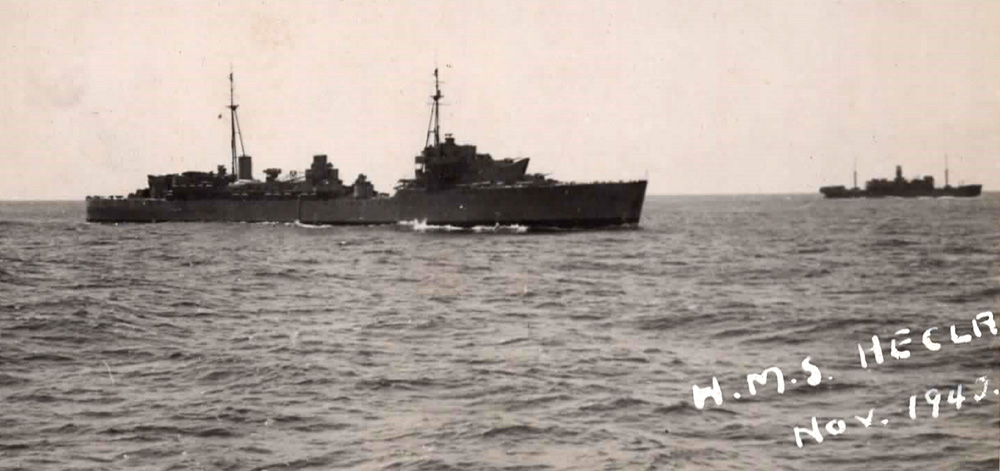
 The photograph of him wearing a cap with the ribbon of the light cruiser HMS Delhi
which was badly damaged by German bombers at Algiers on the 22nd
November and limped back to Gibraltar for emergency repairs before
returning to Britain in December suggests that Warren joined her for
the voyage.
The photograph of him wearing a cap with the ribbon of the light cruiser HMS Delhi
which was badly damaged by German bombers at Algiers on the 22nd
November and limped back to Gibraltar for emergency repairs before
returning to Britain in December suggests that Warren joined her for
the voyage.  This
was Warren Smith's first visit to the country his family had left at
the end of the previous century. It was a country divided by class
rather than colour but it was also a country at war where men were away
from home in the armed forces and women were doing men's jobs. We do
not know how long he stayed in Britain after his two weeks survivor's
leave but we do know that during this time he met Len Ellis, a fellow
South African on survivors leave from the RN after his ship was
torpedoed taking amnumition to Malta. This led to Warren Smith's
younger brother Dennis meeting and marrying Len's sister Yvonne. Len
Ellis transferred to the South African Navy and ended up as Yeoman of
Signals and Aide to Admiral Bierman. Dennis wanted to join the SAN but
was told to "go back to school" so he added a year to his age and
"ended up serving in Italy with the 67th SA Armoured Division".
This
was Warren Smith's first visit to the country his family had left at
the end of the previous century. It was a country divided by class
rather than colour but it was also a country at war where men were away
from home in the armed forces and women were doing men's jobs. We do
not know how long he stayed in Britain after his two weeks survivor's
leave but we do know that during this time he met Len Ellis, a fellow
South African on survivors leave from the RN after his ship was
torpedoed taking amnumition to Malta. This led to Warren Smith's
younger brother Dennis meeting and marrying Len's sister Yvonne. Len
Ellis transferred to the South African Navy and ended up as Yeoman of
Signals and Aide to Admiral Bierman. Dennis wanted to join the SAN but
was told to "go back to school" so he added a year to his age and
"ended up serving in Italy with the 67th SA Armoured Division".